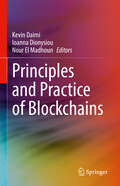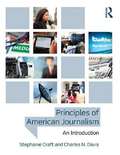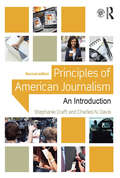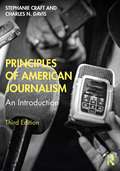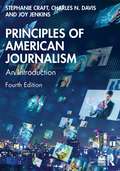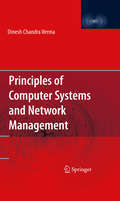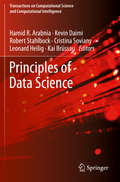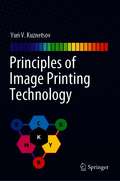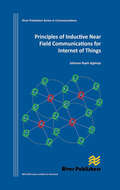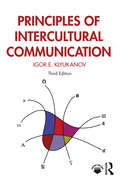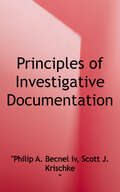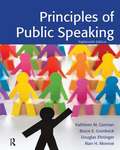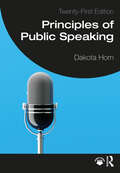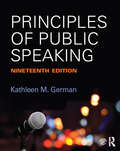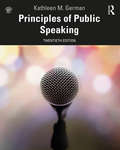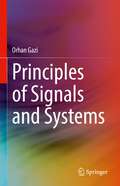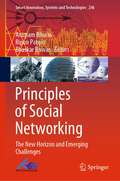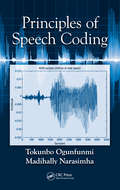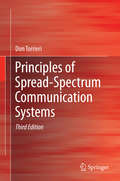- Table View
- List View
Principles and Applications of Optical Wireless Orthogonal Frequency-Division Multiplexing (Optical Wireless Communication Theory and Technology)
by Xizheng KeThis book explains the principles and various applications of Optical Wireless Communication Orthogonal Frequency Division Multiplexing (OWC-OFDM) and validates the relevant theories through numerical analysis and communication experiments. The book consists of 10 chapters, first providing a systematic and in-depth analysis of the research progress of optical wireless communication and clarifying the importance and advantages of optical wireless OFDM transmission. Then the source coding is discussed, the optical OFDM system is clarified, and the characteristics of optical wireless OFDM are explained by numerical simulation. Theoretical analysis and numerical simulation of peak ratio, time synchronization, channel estimation, and channel allocation of wireless OFDM are carried out. Numerical simulation and communication experiments in the book verify the performance of optical wireless OFDM systems and the feasibility of related algorithms.
Principles and Practice of Blockchains
by Kevin Daimi Nour El Madhoun Ioanna DionysiouThis book provides an essential compilation of relevant and cutting edge academic and industry work on key Blockchain topics. This book concentrates on a wide range of advances related to Blockchains which include, among others, Blockchain principles, architecture and concepts with emphasis on key and innovative theories, methodologies, schemes and technologies of Blockchain, Blockchain platforms and architecture, Blockchain protocols, sensors and devices for Blockchain, Blockchain foundations, and reliability analysis of Blockchain-based systems. Further, it provides a glimpse of future directions where cybersecurity applications are headed. The book is a rich collection of carefully selected and reviewed manuscripts written by diverse cybersecurity application experts in the listed fields and edited by prominent cybersecurity applications researchers and specialists.
Principles of American Journalism: An Introduction
by Stephanie Craft Charles N. DavisIn a rapidly changing media landscape, what becomes of journalism? Designed to engage, inspire and challenge students while laying out the fundamental principles of the craft, Principles of American Journalism introduces students to the core values of journalism and its singularly important role in a democracy. From the First Amendment to Facebook, Stephanie Craft and Charles N. Davis provide a comprehensive exploration of the guiding principles of journalism--the ethical and legal foundations of the profession, its historical and modern precepts, the economic landscape, the relationships among journalism and other social institutions, and the key issues and challenges that contemporary journalists face. Case studies, discussion questions and field exercises help students to think critically about journalism's function in society, creating mindful practitioners of journalism and more informed media consumers. With its bottom line under assault, its values being challenged from without and from within and its future anything but certain, it has never been more important to think about what's unique about journalism. This text is ideal for use in introductory Principles of Journalism courses, and the companion website provides a full complement of student and instructor resources to enhance the learning experience and connect to the latest news issues and events.
Principles of American Journalism: An Introduction
by Stephanie Craft Charles N. DavisDesigned to engage, inspire and challenge students while laying out the fundamentals of the craft, Principles of American Journalism introduces readers to the core values of journalism and its singular role in a democracy. From the First Amendment to Facebook, the new and revised edition of this popular textbook provides a comprehensive exploration of the guiding principles of journalism and what makes it unique: the profession's ethical and legal foundations; its historical and modern precepts; the economic landscape of journalism; the relationships among journalism and other social institutions; the key issues and challenges that contemporary journalists face. Case studies, exercises, and an interactive companion website encourage critical thinking about journalism and its role in society, making students more mindful practitioners of journalism and more informed media consumers.
Principles of American Journalism: An Introduction
by Stephanie Craft Charles N. DavisDesigned to engage, inspire, and challenge students while laying out the fundamentals of the craft, this textbook introduces readers to the core values of journalism and its singular role in a democracy. From the First Amendment to Facebook, this popular textbook – now in its third edition – provides a comprehensive exploration of the guiding principles of journalism and what makes it unique. Authors Stephanie Craft and Charles Davis cover the profession's ethical and legal foundations, its historical and modern precepts, the economic landscape of journalism, the relationships among journalism and other social institutions, and the key issues and challenges that contemporary journalists face. They also discuss the current ambiguities and transitions – economic and technological – occurring in the field, from nonprofit news sites to social media’s effects on journalism. Filled with relevant case studies, exercises, and discussion questions that encourage critical thinking about journalism and its role in society, this book helps students become better-informed media consumers as well as more mindful practitioners of journalism. The companion website features chapter-by-chapter flashcards, quizzes, and annotated weblinks for students and a separate instructor resource section that features sample test questions, PowerPoint slides, sample syllabi, and chapter-by-chapter activities and discussion questions.
Principles of American Journalism: An Introduction
by Stephanie Craft Charles N. Davis Joy JenkinsDesigned to engage, inspire and challenge students while laying out the fundamentals of the craft, this textbook—now in its fourth edition—introduces readers to the core values of journalism and its singular role in a democracy.From the First Amendment to artificial intelligence, this popular textbook provides a comprehensive exploration of the guiding principles of journalism and what makes it unique. Authors Stephanie Craft, Charles N. Davis and Joy Jenkins cover the profession's ethical and legal foundations, its historical and modern precepts, the economic landscape of journalism, the relationships among journalism and other social institutions and the key issues and challenges that contemporary journalists face. They also discuss the current ambiguities and transitions—economic and technological—occurring in the field, from nonprofit news sites to social media’s effects on journalism.Filled with relevant case studies, exercises and discussion questions that encourage critical thinking about journalism and its role in society, this book helps students become better-informed media consumers as well as more mindful practitioners of journalism.
Principles of Automated Negotiation
by Shaheen Fatima Sarit Kraus Michael WooldridgeWith an increasing number of applications in the context of multi-agent systems, automated negotiation is a rapidly growing area. Written by top researchers in the field, this state-of-the-art treatment of the subject explores key issues involved in the design of negotiating agents, covering strategic, heuristic, and axiomatic approaches. The authors discuss the potential benefits of automated negotiation as well as the unique challenges it poses for computer scientists and for researchers in artificial intelligence. They also consider possible applications and give readers a feel for the types of domains where automated negotiation is already being deployed. This book is ideal for graduate students and researchers in computer science who are interested in multi-agent systems. It will also appeal to negotiation researchers from disciplines such as management and business studies, psychology and economics.
Principles of Computer Systems and Network Management
by Dinesh Chandra VermaSystems Management is emerging as the predominant area for computer science in the enterprise, with studies showing that the bulk (up to 80%) of an enterprise IT budget is spent on management/operational issues and is the largest piece of the expenditure. This textbook provides an overview of the field of computer systems and network management. Systems management courses are being taught in different graduate and undergraduate computer science programs, but there are no good books with a comprehensive overview of the subject. This text book will provide content appropriate for either an undergraduate course (junior or senior year) or a graduate course in systems management.
Principles of Data Science (Transactions on Computational Science and Computational Intelligence)
by Hamid R. Arabnia Robert Stahlbock Kevin Daimi Cristina Soviany Leonard Heilig Kai BrüssauThis book provides readers with a thorough understanding of various research areas within the field of data science. The book introduces readers to various techniques for data acquisition, extraction, and cleaning, data summarizing and modeling, data analysis and communication techniques, data science tools, deep learning, and various data science applications. Researchers can extract and conclude various future ideas and topics that could result in potential publications or thesis. Furthermore, this book contributes to Data Scientists’ preparation and to enhancing their knowledge of the field. The book provides a rich collection of manuscripts in highly regarded data science topics, edited by professors with long experience in the field of data science.Introduces various techniques, methods, and algorithms adopted by Data Science expertsProvides a detailed explanation of data science perceptions, reinforced by practical examplesPresents a road map of future trends suitable for innovative data science research and practice
Principles of Digital Communication
by Robert G. GallagerThe renowned communications theorist Robert Gallager brings his lucid writing style to the study of the fundamental system aspects of digital communication for a one-semester course for graduate students. With the clarity and insight that have characterized his teaching and earlier textbooks, he develops a simple framework and then combines this with careful proofs to help the reader understand modern systems and simplified models in an intuitive yet precise way. A strong narrative and links between theory and practice reinforce this concise, practical presentation. The book begins with data compression for arbitrary sources. Gallager then describes how to modulate the resulting binary data for transmission over wires, cables, optical fibers, and wireless channels. Analysis and intuitive interpretations are developed for channel noise models, followed by coverage of the principles of detection, coding, and decoding. The various concepts covered are brought together in a description of wireless communication, using CDMA as a case study.
Principles of Image Printing Technology
by Yuri V. KuznetsovPrinciples of Image Printing Technology is a unique review of technology use in the printing industry since the time of the medieval engravers and busy newsroom typesetters. It provides a historical review of the advancement of technology and describes in-depth both technical fundamentals and industrial procedures. Intended primarily for students in graphic communications programs, this book includes all the necessary background for understanding printing technology. In addition, by providing findings from basic research studies and industrial processes that have been omitted elsewhere in published volumes, it offers a useful guide to researchers and professionals in the printing industry.
Principles of Inductive Near Field Communications for Internet of Things
by Johnson I. AgbinyaNear field communication devices and the emerging field of Internet of things require efficient short range communication techniques. Classical telecommunication theory however has so far focused on radiating electromagnetic signals which is more suited to terrestrial communication systems. Over the last decade however considerable research and applications of inductive methods have emerged as innovative approaches for secure short range communications by changing the paradigm of an established model of electromagnetic communications. We have witnessed the emergence of embedded inductive medical devices, magneto-inductive waveguides, inductive pots and cooking devices, magneto-inductive sensors, wireless power transfer, inductive hearing aids and the emerging inductive point-to-point communication specifically termed near-field communication (NFC) as used in mobile phones and payment cards to name a few. While there exist a large set of distributed methods and algorithms detailing the design and performances of such applications, a significant gap is observed as a lack of detailed collection of the methods in one place which could be easily understood and used quickly by someone seeking to apply the methods.In this book this missing gap is filled with the required details and the theory of near field communication systems including both the radiating and reactive (energy coupling) near-field systems in addition to the well known far field radiation techniques. The book details the fundamental expressions and design methods which facilitate the creation of near field devices and equipment including embedded biomedical implants. The book contains recent advances in inductive communications, performance, limitations and a collection of applications. It also lays a strong foundation for the application of inductive methods for creating Internet of Things systems.
Principles of Integrated Airborne Avionics (Springer Aerospace Technology)
by Igor Victorovich Avtin Vladimir Ivanovich Baburov Boris Victorovich Ponomarenko Yuri Grigorievich ShatrakovThis book discusses the principles, approaches, concepts and development programs for integrated aircraft avionics. The functional tasks of integrated on-board radio electronic equipment (avionics) of navigation, landing, data exchange and air traffic control are formulated that meet the modern requirements of civil and military aviation, and the principles of avionics integration are proposed. The modern approaches to the joint processing of information in navigation and landing complexes are analyzed. Algorithms of multichannel information processing in integrated avionics are considered, and examples of its implementation are presented. This book is intended for scientists and professionals in the field of aviation equipment, students and graduate students of relevant specialties.
Principles of Intercultural Communication
by Igor E. KlyukanovThis third edition provides a comprehensive view of intercultural communication through its concise style and unique theoretical framework of ten interconnected principles.This edition engages students in active learning by showing how these principles come into play in their intercultural journeys. The new edition has been thoroughly revised, adding new ‘side trips’ and introducing ‘focus in theory’ boxes, chapter glossaries, and fresh examples with updated references. Each chapter again includes detailed case studies with question prompts that invite students to make connections between theory and their daily lives.This text is ideally suited for upper-level or graduate intercultural communication courses within communication, linguistics, and anthropology departments.New to this edition are online materials for instructors, including a test bank and suggested further readings and links to useful resources. Please visit www.routledge.com/9781032613079 to access.
Principles of Investigative Documentation: Creating a Uniform Style for Generating Reports and Packaging Information
by Philip Becnel Scott J. KrischkeThis is the only book in existence that discusses the process of documenting an investigation from start to finish. It presents just about everything an investigator needs to know regarding how to document an investigation. The first chapter discusses the five primary principles of investigative documentation: taking comprehensive notes; documenting every effort to contact witnesses and all surveillance; preparing reports whenever there is any possibility of needing to testify; taking verbatim statements from hostile witnesses and declarations from friendly witnesses; and providing all case documents to the client or maintaining a document retention plan. The second chapter details the numerous misconceptions pertaining to investigative documentation. This chapter sets the stage for the remaining chapters on note-taking, running resumes, reports, statements, and documentation retention. Each chapter is broken down into four or five sections that approximate the methods used to complete that particular documentary endeavor. The book also contains an exhaustive appendix that many investigators will find to be very useful, including: one that lists hundreds of abbreviations that investigators may find helpful when taking notes; sample reports that readers may use as templates for generating their own reports; an alphabetic stylebook that is based on styles used by the media and federal law enforcement agencies that provides a quick tool for properly referencing abbreviations, names, capitalization and numerals, among other topics; and several sample statements and declarations to show what these documents, when completed, are supposed to look like. This is an advanced book for people who already have the necessary skills to do an investigation. By following the principles outlined in this book, investigators will see the quality of their investigations improve markedly and ultimately be more successful.
Principles of LED Light Communications
by Svilen Dimitrov Harald HaasBalancing theoretical analysis and practical advice, this book describes all the underlying principles required to build high performance indoor optical wireless communication (OWC) systems based on visible and infrared light, alongside essential techniques for optimising systems by maximising throughput, reducing hardware complexity and measuring performance effectively. It provides a comprehensive analysis of information rate-, spectral- and power-efficiencies for single and multi-carrier transmission schemes, and a novel analysis of non-linear signal distortion, enabling the use of off-the-shelf LED technology. Other topics covered include cellular network throughput and coverage, static resource partitioning via dynamic interference-aware scheduling, realistic light propagation modelling, OFDM, optical MIMO transmission and nonlinearity modelling. Covering practical techniques for building indoor optical wireless cellular networks supporting multiple users and guidelines for 5G cellular system studies, in addition to physical layer issues, this is an indispensable resource for academic researchers, professional engineers and graduate students working in optical communications.
Principles of Mobile Computing and Communications
by Mazliza OthmanMobile computing technology has come a long way in recent years-providing anytime, anywhere communication and access to information. Bringing students up to date on important technological and industry developments, Principles of Mobile Computing and Communications examines mobile networks and relevant standards, highlighting issues unique to the m
Principles of Public Speaking
by Kathleen M. German Alan H. Monroe Douglas Ehninger Bruce E GronbeckBalancing skills and theory, Principles of Public Speaking emphasizes orality, Internet technology, and critical thinking as it encourages the reader to see public speaking as a way to build community in today's diverse world. Within a framework that emphasizes speaker responsibility, critical thinking and listening, and cultural awareness, this classic book uses examples from college, workplace, political, and social communication to make the study of public speaking relevant, contemporary, and exciting. This brief but comprehensive book also offers the reader the latest in using technology in speechmaking, featuring a unique and exciting integrated text and technology learning system.
Principles of Public Speaking
by Dakota HornNow in its 21st edition, this introductory public speaking textbook encourages the reader to see public speaking as a way to build community in today’s diverse world.Within a framework that emphasizes speaker responsibility, listening, and cultural awareness, this classic book uses examples from college, the workplace, and political and social communication to make the study of public speaking relevant, contemporary, and exciting. Balancing skills and theory, new author Dakota Horn provides expanded coverage of speaking anxiety and understanding and delivering digital presentations along with two new chapters on culture and diversity and diversifying speeches. Each chapter also contains in-class applied activities to support students' learning.This textbook is ideal for general courses on public speaking as well as specialized programs in business, management, political communication, and public affairs.An Instructor’s Manual featuring discussion questions and guides, exercises, quiz questions, and suggestions and resources for syllabus design as well as PowerPoint slides is available at https://www.routledge.com/9781032537634
Principles of Public Speaking
by Kathleen GermanBalancing skills and theory, Principles of Public Speaking, 19th Edition, emphasizes orality, internet technology, and critical thinking as it encourages the reader to see public speaking as a way to build community in today’s diverse world. Within a framework that emphasizes speaker responsibility, listening, and cultural awareness, this classic book uses examples from college, workplace, political, and social communication to make the study of public speaking relevant, contemporary, and exciting. This edition opens with a new chapter on speaking apprehension, and offers enhanced online resources for instructors and students.
Principles of Public Speaking
by Kathleen GermanBalancing skills and theory, this introductory public speaking textbook encourages the reader to see public speaking as a way to build community in today’s diverse world. Within a framework that emphasizes speaker responsibility, listening, and cultural awareness, this classic book uses examples from college, workplace, political, and social communication to make the study of public speaking relevant, contemporary, and exciting. This new edition includes expanded coverage of mediated speaking with examples from podcasts and online speaking contexts; discussion of ethical issues of contemporary public discourse, including disinformation and public civility; and tips for extemporaneous speaking. This textbook is ideal for general courses on public speaking as well as specialized programs in business, management, political communication, and public affairs. A companion website including an instructor’s manual containing discussion questions, exercises, quiz questions, and suggestions for syllabus design is available at www.routledge.com/cw/german.
Principles of Signals and Systems
by Orhan GaziThe textbook presents basic concepts of signals and systems in a clear manner, based on the author’s 15+ years of teaching the undergraduate course for engineering students. To attain full benefit from the content, readers should have a strong knowledge of calculus and be familiar with integration, differentiation, and summation operations. The book starts with an introduction to signals and systems and continues with coverage of basic signal functions and their manipulations; energy, power, convolution, and systems; Fourier analysis of continuous time signals and digital signals; Laplace transform; and Z transforms. Practical applications are included throughout. The book is also packed with solved examples, self-study exercises, and end of chapter problems.
Principles of Social Networking: The New Horizon and Emerging Challenges (Smart Innovation, Systems and Technologies #246)
by Ripon Patgiri Anupam Biswas Bhaskar BiswasThis book presents new and innovative current discoveries in social networking which contribute enough knowledge to the research community. The book includes chapters presenting research advances in social network analysis and issues emerged with diverse social media data. The book also presents applications of the theoretical algorithms and network models to analyze real-world large-scale social networks and the data emanating from them as well as characterize the topology and behavior of these networks. Furthermore, the book covers extremely debated topics, surveys, future trends, issues, and challenges.
Principles of Speech Coding
by Tokunbo Ogunfunmi Madihally NarasimhaIt is becoming increasingly apparent that all forms of communication-including voice-will be transmitted through packet-switched networks based on the Internet Protocol (IP). Therefore, the design of modern devices that rely on speech interfaces, such as cell phones and PDAs, requires a complete and up-to-date understanding of the basics of speech
Principles of Spread-Spectrum Communication Systems
by Don TorrieriThis textbook provides a concise but lucid explanation of the fundamentals of spread-spectrum systems with an emphasis on theoretical principles. The choice of specific topics is tempered by the author's judgment of their practical significance and interest to both researchers and system designers. Throughout the book, learning is facilitated by many new or streamlined derivations of the classical theory. Problems at the end of each chapter are intended to assist readers in consolidating their knowledge and to provide practice in analytical techniques. This third edition includes new coverage of topics such as CDMA networks, Acquisition and Synchronization in DS-CDMA Cellular Networks, Hopsets for FH-CDMA Ad Hoc Networks, and Implications of Information Theory, as well as updated and revised material on Central Limit Theorem, Power Spectral Density of FH/CPM Complex Envelopes, and Anticipative Adaptive-Array Algorithm for Frequency-Hopping Systems.

